The paurotis or Everglades palm is a clustering, fan-leaved palm with very slender (2–3-inch diameter) stems. It can reach heights up to 30 feet, with a spread of 20 feet. The light green leaves have blades about 2 feet across on spiny petioles up to 3 feet long (Figure 1). The stems are covered with fibers and persistent leaf bases. In the spring paurotis palms produce large inflorescences of creamy white flowers that extend well beyond the foliage. These are followed in the summer by ¼-inch round fruits that pass through green and orange stages but turn black when completely ripe (Figure 2). Paurotis palms are rather slow-growing and are not tolerant of salt spray.

Credit: Stephen Brown, UF/IFAS
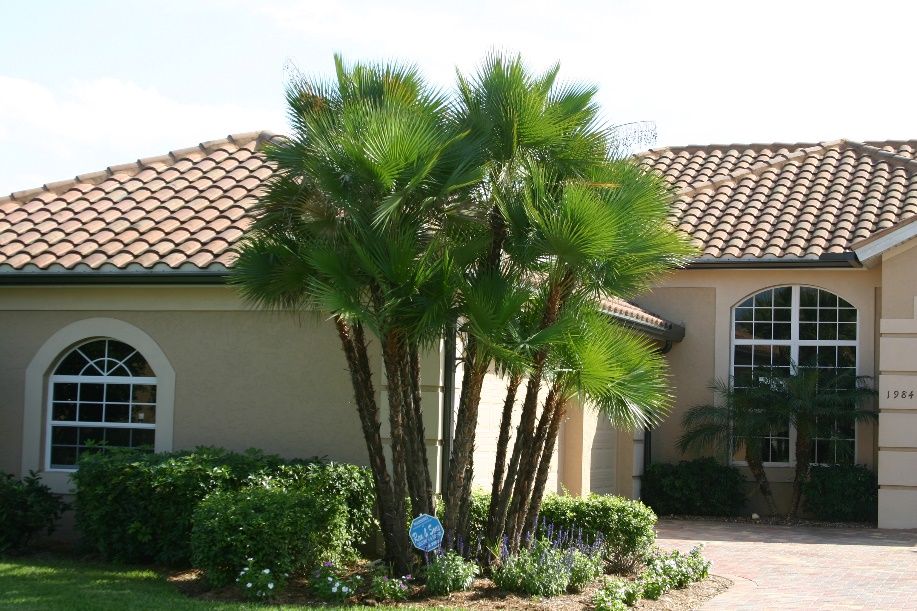
Credit: Stephen Brown, UF/IFAS
Paurotis palms are cold hardy to about 22°F–25°F or USDA Cold Hardiness Zone 9A-11. The species is native to moist environments in south Florida, Central America, and the West Indies, but it does not grow well in calcareous soils such as those found in road rights-of-way, parking lots, and typical built-up landscapes in south and central Florida. Under these soil conditions, paurotis palms suffer greatly from manganese (Mn) deficiency, which often kills them. Manganese deficiency is characterized by chlorotic new leaves with longitudinal necrotic streaks within the leaf segments (Figure 3). As the deficiency becomes more severe, leaf segment tips begin to wither and curl, hence the common name "frizzletop" (Figure 4). Individual stems may die from Mn deficiency. See Manganese Deficiency in Palms (EDIS EP267) for more information about this disorder.
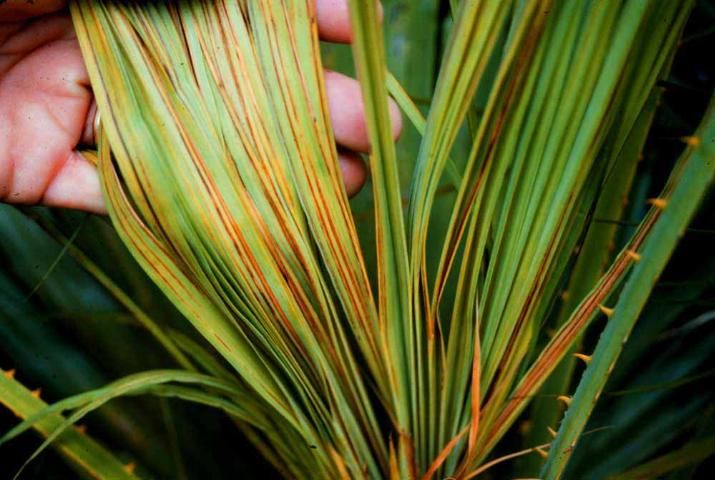
Credit: T. K. Broschat, UF/IFAS
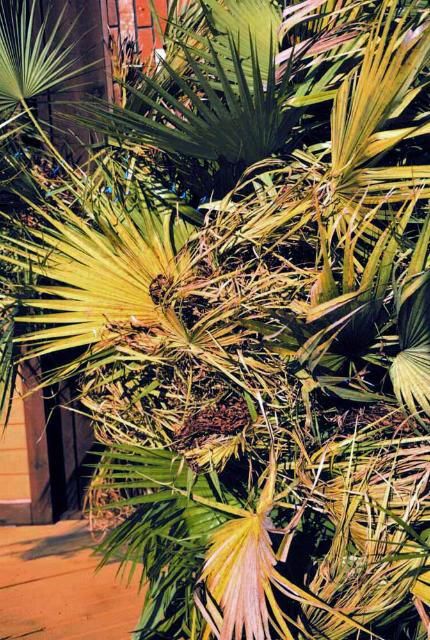
Credit: T. K. Broschat, UF/IFAS
Another nutritional problem that is nearly ubiquitous in paurotis palms in Florida soils is potassium (K) deficiency. It causes black necrotic, and occasionally translucent yellow-orange, spots on the oldest leaves. Potassium deficiency also causes premature loss of older leaves and reduces the number of leaves that a palm can support. In severe cases, individual stems may die from K deficiency. See Potassium Deficiency in Palms (EDIS EP269) for more information about this disorder.
The only other nutritional problem that is occasionally seen in paurotis palms is iron (Fe) deficiency. This deficiency causes new leaves to emerge uniformly greenish-yellow. In chronic cases the entire canopy will be this color (Figure 5). Iron deficiency is not caused by a lack of Fe in the soil, but rather by root-related problems such as poor soil aeration or deep planting. While high soil pH is a common cause of Fe deficiency in broadleaf plants, in palms high soil pH is more likely to result in a deficiency of Mn than of Fe. See Iron Deficiency in Palms (EDIS EP265) for more information about this deficiency.
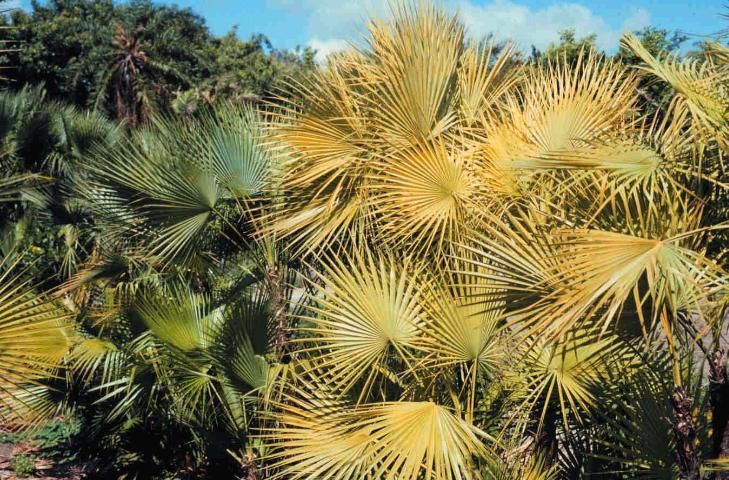
Credit: T. K. Broschat, UF/IFAS
Paurotis palms should be fertilized every 3 months with a controlled release 8-2-12-4 Mg (or 8-0-12-4 Mg) plus micronutrients fertilizer. In calcareous soils, these palms may require additional manganese sulfate to keep them healthy. See Fertilization of Field-grown and Landscape Palms in Florida (EDIS EP261) for details about palm fertilization.
One "problem" occasionally encountered in older specimens of this species is a twisting of the stems (Figure 6). It is the result of long, slender stems spreading out from the clump and the new growth attempting to grow more upward from stems leaning at an angle from the vertical. After several feet of new growth appears, the affected stems often rotate downward under their own weight, then resume upward growth. Each time this occurs, a new twist in the stem occurs. While the stems are severely deformed, this does not affect the health of the palm.
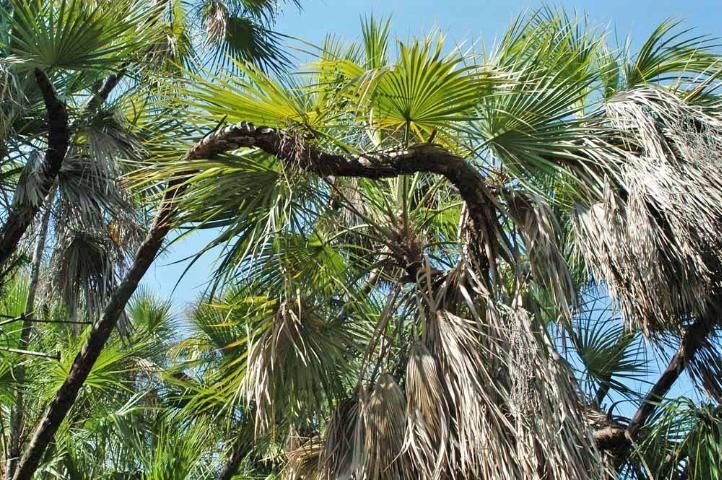
Credit: T. K. Broschat, UF/IFAS
Pruning of dead leaves or flower or fruit stalks can be done at any time. Avoid cutting off potassium-deficient older leaves, as these leaves serve as a supplemental source of K in the absence of sufficient K in the soil. For additional information about pruning palms see Pruning Palms (EDIS EP443).
Diseases of paurotis palms are not common. The most serious one observed is Ganoderma butt rot, a disease caused by Ganoderma zonatum. It causes a trunk rot in the lower 3-4 feet of a stem, and once started, will slowly kill off a clump, one stem at a time (Figure 7). Shelf-like fruiting structures on the stems called conks may or may not be present before a stem dies. There is no treatment for this disease, but the practice of cutting out mature stems can encourage the establishment of this disease. See Ganoderma Butt Rot of Palm (EDIS PP100) for more information about this disease.
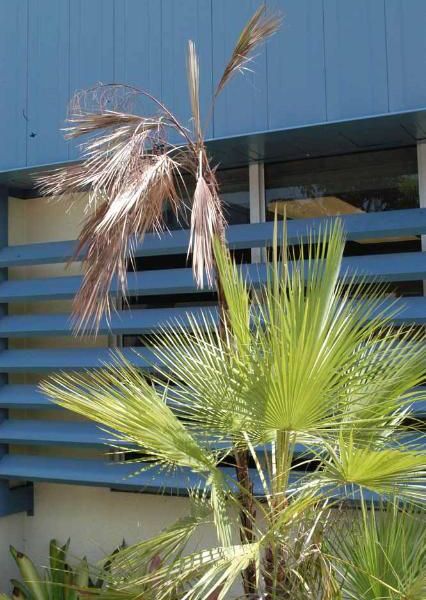
Credit: T. K. Broschat, UF/IFAS
References
Broschat, T. K. 1990. "Potassium deficiency of palms in south Florida." Principes 34:151–155.
Elliott, M. L., T. K. Broschat, J. Y. Uchida, and G. W. Simone. 2004. Compendium of diseases and disorders of ornamental palms. St. Paul, MN. American Phytopathological Society Press.
Meerow, A. W. 2006. Betrock's landscape palms. Hollywood, FL: Betrock Information Systems.